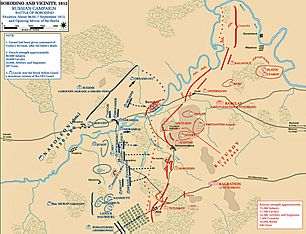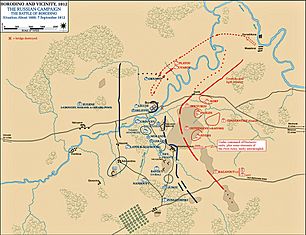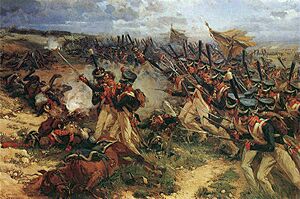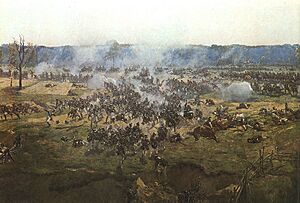Battle of Borodino facts for kids
Quick facts for kids Battle of Borodino |
|||||||||
|---|---|---|---|---|---|---|---|---|---|
| Part of the French invasion of Russia | |||||||||
 Battle of Moscow, 7th September 1812 (painting by Louis-François Lejeune, 1822) |
|||||||||
|
|||||||||
| Belligerents | |||||||||
|
|||||||||
| Commanders and leaders | |||||||||
|
|||||||||
| Strength | |||||||||
| 103,000–135,000 | 125,000–160,000 | ||||||||
| Casualties and losses | |||||||||
| 28,000–35,000 killed, wounded or captured | 45,000–52,000 killed, wounded or captured | ||||||||
The Battle of Borodino was a huge and very bloody fight that happened near the village of Borodino on September 7, 1812. It was a key part of Napoleon's invasion of Russia.
Napoleon's army, called the Grande Armée, won the battle. However, they didn't completely crush the Russian army and lost a huge number of soldiers. Napoleon fought against General Mikhail Kutuzov, who had just taken command of the Russian forces.
Even though the French won, the Russian army was still strong enough to retreat in an organized way. This battle greatly weakened Napoleon's army. It allowed the Russians to use Moscow as a trap for the French. Many historians believe Napoleon made a big mistake by not using his best troops, the Imperial Guard, to finish off the Russian army.
About 250,000 soldiers fought in this battle. It was the single bloodiest day of the entire Napoleonic Wars, with tens of thousands of soldiers killed or wounded.
Contents
The Invasion of Russia
Why the Battle Happened
Napoleon's Grande Armée began its invasion of Russia on June 24, 1812. They crossed the Niemen River with a massive army.
The Russian army, led by Barclay de Tolly, was much smaller. So, they decided to retreat deeper into Russia. This tactic, called a "delaying operation," aimed to slow down the French and cause them damage without fighting a huge battle. It was like trading land for time.
After the Battle of Smolensk, the Russian Tsar (Emperor) replaced Barclay de Tolly with General Kutuzov. The Russian people and soldiers were tired of retreating. They wanted to fight.
Kutuzov understood that retreating had been smart, but he knew a battle had to happen to keep up everyone's spirits. He chose a spot near Borodino for the big fight.
Preparing the Battlefield
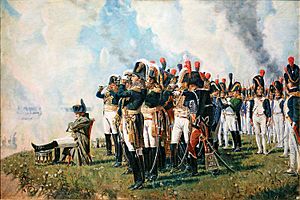
The Borodino area was quite open, without many natural defenses. But it was chosen because it blocked the main roads to Moscow. Starting on September 3, Kutuzov ordered his men to build strong defenses.
These defenses included earthworks, which are like small forts made of earth. One important one was the Raevsky Redoubt in the center. On the left side, there were three arrow-shaped defenses called "Bagration flèches" (pronounced "flesh-es").
The Battle of Shevardino
Before the main battle, there was a smaller fight on September 5. The Russians had built a fort called the Shevardino Redoubt. It was meant to delay the French and protect the Russian army as they moved their lines.
French forces, led by Marshal Joachim Murat, attacked the redoubt. The fighting was very fierce. The Russians fought hard and only retreated when General Kutuzov ordered them to.
The French captured the redoubt, but it cost them many soldiers. Both sides lost thousands of men in this early fight. The fall of Shevardino meant the Russian left side was now open to attack.
The Armies Face Off
Who Fought at Borodino
The Russian army had been changing and improving over the years. By the time of Borodino, it was much stronger than before.
The Russians had about 155,200 soldiers, including many infantry (foot soldiers), cavalry (horse soldiers), and artillery (cannons). They also had thousands of Cossacks, who were skilled horsemen.
The French army, led by Napoleon, was considered one of the best armies in the world. Each part of their army could fight on its own.
The French had about 128,000 soldiers, with many infantry, cavalry, and cannons. However, Napoleon chose not to use his best troops, the Imperial Guard, in the main battle.
The Battle Begins
The Battle Plan
The Russian defenses at Borodino stretched in a curve. On the right, they were protected by the Moskva River. In the center, the Raevsky Redoubt was a huge fort with 19 cannons.
General Kutuzov was worried Napoleon might try to go around his army to reach Moscow. So, he put his strongest forces, the 1st Army, on the right side, where the defenses were already very strong. The 2nd Army, under General Bagration, was on the left, which was weaker.
When the battle started, the French focused their attacks on the weaker Russian left. This meant many of the Russian cannons on the right side were not used effectively.
Fighting at the Bagration Flèches
The first major attacks happened at the Bagration Flèches. These were three arrow-shaped forts that stuck out from the Russian left side. They were important because they helped defend an area without natural barriers.
Napoleon ordered his troops to attack these forts head-on. The battle started at 6:00 AM with a huge French cannon attack. French soldiers rushed forward, but they were met with heavy Russian cannon fire.
The fighting was incredibly intense. The forts changed hands many times. French and Russian soldiers fought hand-to-hand in thick smoke and dust. It was hard to see or move because of all the dead and wounded soldiers.
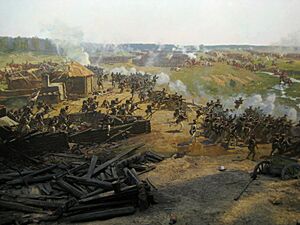
The French attacked the flèches seven times, but each time the Russians fought them back. General Bagration, who was leading the Russian defense there, was hit by cannonball pieces around 11:00 AM. He was badly wounded and had to leave the battlefield.
With Bagration gone, the Russian command on the left side became confused. Napoleon, who was not close enough to see everything clearly, refused to send his best troops, the Imperial Guard, to help. He wanted to save them.
Attacks on the Raevsky Redoubt
While the flèches were being fought over, another part of the French army, led by Prince Eugène, attacked the village of Borodino. They captured it, but then the Russians fought back and pushed them out.
Eugène's forces then moved towards the Raevsky Redoubt, the large fort in the center of the Russian line. They used many cannons to pound the Russian defenses. The redoubt was captured and recaptured several times.
The fighting was like "a walk into Hell" according to one general. Many Russian cannons were not used because their commander was killed. Meanwhile, French artillery caused terrible damage to the Russians.
Cossack Attack on the Side
In the morning, some Don Cossacks, who are Russian horsemen, found a way to cross the Kolocha River on the far right of the Russian line. They saw a chance to attack the French from behind.
The Cossack leader, Matvei Platov, asked for permission to do this. General Kutuzov agreed, and another cavalry group joined them. They had about 8,000 horsemen but no foot soldiers.
When these Russian cavalry units appeared behind the French lines, it caused a lot of panic. Prince Eugène, who was about to attack the Raevsky Redoubt again, had to stop his attack and move his troops to deal with the Cossacks.
Even though the Cossacks didn't cause much damage, their surprise attack was very important. It delayed the French attack on the Raevsky Redoubt for two crucial hours. This gave the Russians time to bring in more troops and get ready for the next French push.
Final Attack on Raevsky Redoubt
Around 2:00 PM, Napoleon ordered another massive attack on the Raevsky Redoubt. French divisions launched a frontal assault, supported by cavalry.
The Russian soldiers inside the redoubt fought bravely, shouting, "Brothers, behind us is Moscow!" The fighting was so close that the cannon operators had to fight hand-to-hand.
French cavalry, led by General Auguste-Jean-Gabriel de Caulaincourt, charged into the redoubt. Caulaincourt was killed, but the French eventually captured the position. By 3:30 PM, the Raevsky Redoubt had fallen.
However, the French were too tired to push further. The Russian Guard Cavalry charged and stopped any more French advances.
Fighting at Utitsa
The third main fighting area was around the village of Utitsa, on the far left of the Russian line. This area was tricky, with thick woods and marshy ground, perfect for light infantry.
Polish troops, part of Napoleon's army, attacked Utitsa. They captured the village and a nearby mound. But the Russian general, Nikolay Tuchkov, led a counter-attack and took them back. He was badly wounded during this fight.
The Poles attacked again and recaptured Utitsa, which was set on fire. The thick woods made it hard for the Polish troops to move forward. The fighting continued there all day, but neither side made much progress.
Napoleon's Decision Not to Use the Guard
By 3:00 PM, the Russian army was in a very bad state, but the French were also exhausted. Napoleon's generals urged him to send in his Imperial Guard, his best and freshest troops, to finish the battle.
They believed that using the Guard would completely break the Russian army and win the war. However, Napoleon refused. He said he didn't want to risk his best troops so far from France. He chose instead to use a massive cannon attack with 400 guns.
After the Battle
End of the Day
After the redoubts were taken, Napoleon went to see the battlefield. The Russians had moved back to another ridge, but the dust and smoke made it hard to see how disorganized they were. The Russian Guard held their new line, even under heavy French cannon fire.
Napoleon didn't try any more big attacks. The battle ended with both sides exhausted. The Russians had suffered huge losses, but their army was still mostly together.
Kutuzov knew his army was too hurt to fight another big battle the next day. He decided to retreat further towards Moscow. This allowed the Russian army to recover and forced the French to move even further from their supplies.
On September 8, the Russian army left the battlefield. Napoleon then marched into Moscow a week later.
The Cost of Victory
The Battle of Borodino was incredibly costly. Around 250,000 soldiers fought, and at least 68,000 were killed or wounded. This makes it the deadliest single-day battle of the Napoleonic Wars.
The French Grande Armée lost about 28,000 to 35,000 soldiers. Many of these died from their wounds, starvation, or neglect because there wasn't enough food or medical care. Forty-nine French generals were killed or wounded.
The Russians lost even more, about 44,000 to 52,000 soldiers. Twenty-two Russian generals were killed or wounded, including Prince Bagration, who died from his injuries later.
Both armies lost more than a third of their soldiers. It was a terrible price to pay.
A Costly Victory for Napoleon
Historians often call Borodino a "Pyrrhic victory." This means it was a victory that came at such a high cost that it felt like a defeat.
Napoleon captured Moscow, but the city was burned and abandoned. The Russians had no intention of surrendering. As winter approached, Napoleon realized he was trapped. The Russian army, though weakened, regrouped and attacked the French as they tried to retreat.
The Russians used a strategy called attrition warfare. This meant they slowly wore down the French army by burning resources, using guerrilla warfare (small, surprise attacks) against supply lines, and having peasants fight against French foraging parties. This made it very hard for the French to get food and supplies.
Of the more than 600,000 soldiers who invaded Russia, fewer than 100,000 returned alive. Borodino was a major reason for this massive loss, as it severely weakened Napoleon's army far from home.
Legacy of Borodino
The Battle of Borodino is a very important event in Russian history.
- The famous composer Pyotr Ilyich Tchaikovsky wrote his 1812 Overture to celebrate the battle.
- The battle is famously described in Leo Tolstoy's novel War and Peace.
- Poet Mikhail Lermontov wrote a well-known poem about the battle called Borodino.
- A huge panoramic painting of the battle was created by Franz Roubaud in 1912. It is displayed in Moscow.
- In Russia, the Battle of Borodino is reenacted every year on the first Sunday of September. It is a Day of Military Honour.
- The old forts, like the Bagration Flèches, are still preserved on the battlefield. There is also a monument to the French soldiers who died.
- A minor planet discovered in 1977 was named 3544 Borodino after the village.
- Many ships have been named Borodino and after the generals who fought in the battle.
Images for kids
-
1987 Soviet commemorative coin, reverse
See also
- Military career of Napoleon Bonaparte
- List of battles of the French invasion of Russia
- Nikolay Vuich
- Ivan Shevich
- Andrei Miloradovich
- Avram Ratkov
- Ivan Adamovich
- Nikolay Bogdanov
- Ilya Duka
- Georgi Emmanuel
- Peter Ivanovich Ivelich



